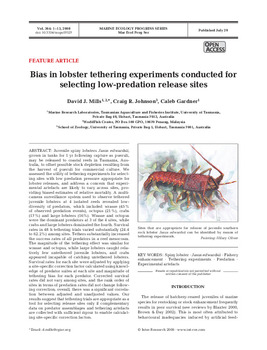Bias in lobster tethering experiments conducted for selecting low-predation release sites

Citation
Mills, D.J.; Johnson, C.R.; Gardner, C. (2008). Bias in lobster tethering experiments conducted for selecting low-predation release sites. Marine Ecology Progress Series 364:1-13
Juvenile spiny lobsters Jasus edwardsii, grown in tanks for 1 yr following capture as pueruli, may be released to coastal reefs in Tasmania, Australia, to offset possible stock depletion resulting from the harvest of pueruli for commercial culture. We assessed the utility of tethering experiments for selecting sites with low predation pressure appropriate for lobster releases, and address a concern that experimental artefacts are likely to vary across sites, providing biased estimates of relative mortality. A multicamera surveillance system used to observe tethered juvenile lobsters at 4 isolated reefs revealed lowdiversity of predators, which included wrasse (45% of observed predation events), octopus (21%), crabs (17%) and large lobsters (16%). Wrasse and octopus were the dominant predators at 3 of the 4 sites, while crabs and large lobsters dominated the fourth. Survival rates in 48 h tethering trials varied substantially (24.4 to 62.2%) among sites. Tethers substantially increased the success rates of all predators in a reef mesocosm. The magnitude of the tethering effect was similar for wrasse and octopus, while large lobsters caught relatively few untethered juvenile lobsters, and crabs appeared incapable of catching untethered lobsters. Survival rates for each site were adjusted by applying a site-specific correction factor calculated using knowledge of predator suites at each site and magnitude of tethering bias for each predator. Corrected survival rates did not vary among sites, and the rank order of sites in terms of predation rates did not change following correction; overall, there was a significant correlation between adjusted and unadjusted values. Our results suggest that tethering trials are appropriate as a tool for selecting release sites only if complementary data on predator assemblages and tethering artefacts are collected with sufficient rigour to enable calculating site-specific correction factors.
Permalink
Date Available
Type
Publisher
ISSN
0171-8630
Copyright
CC BY 4.0
Topics
Language